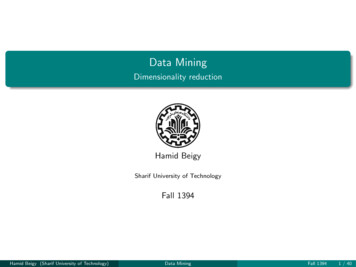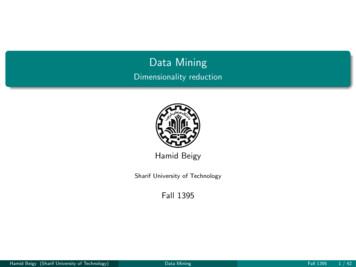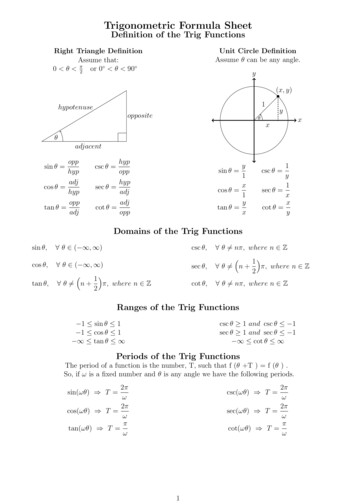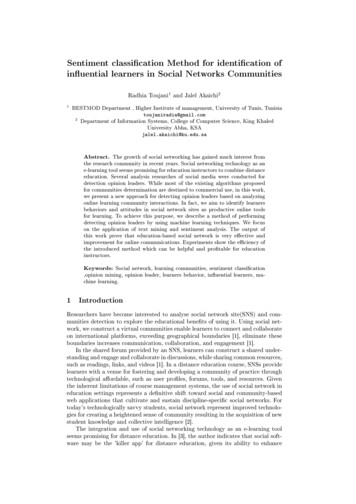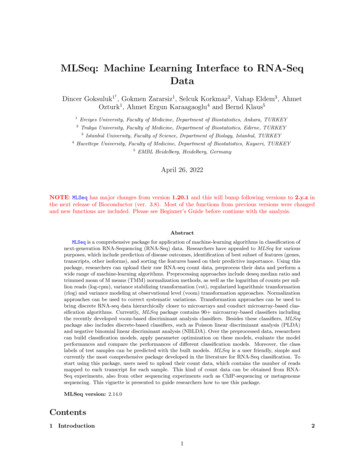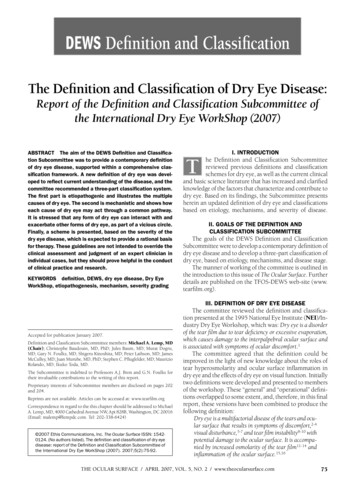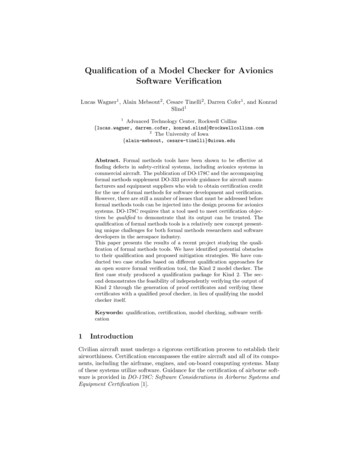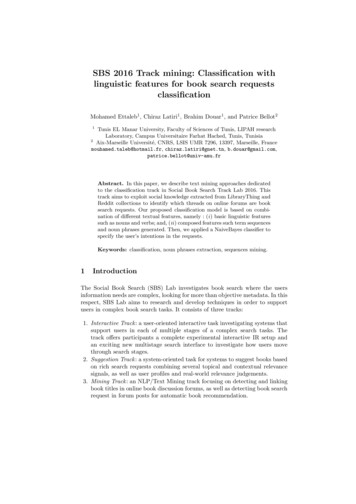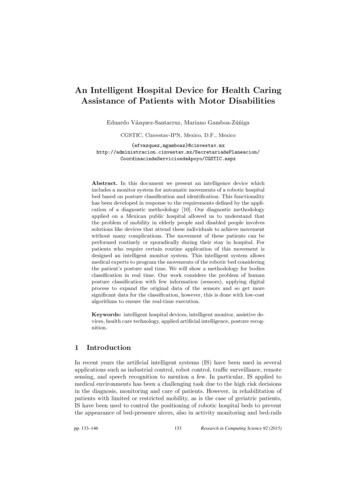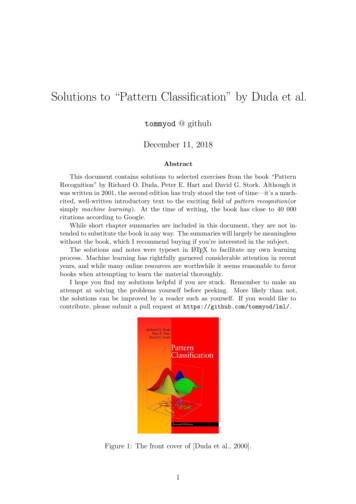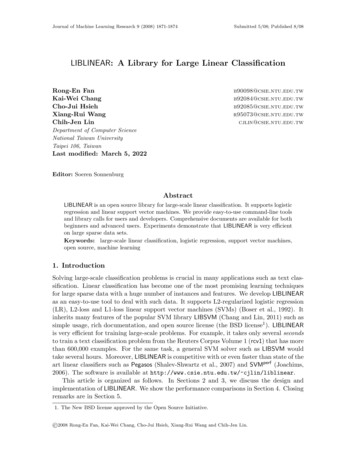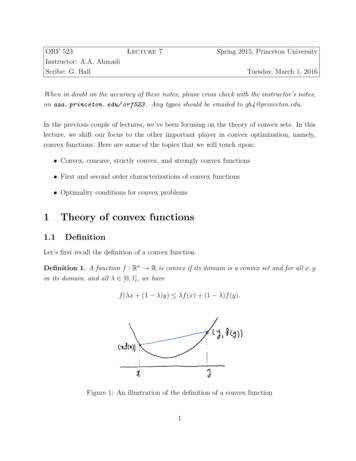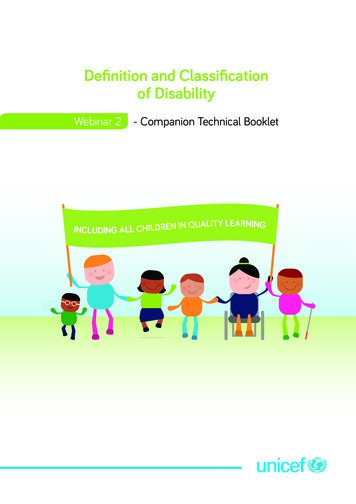
Transcription
Definition and Classificationof DisabilityWebinar 2- Companion Technical BookletUALITY LEARNINGINCLUDING ALL CHILDREN IN Q
United Nations Children’s Fund (UNICEF) 2014About the author: Professor Judith Hollenweger is thehead of the priority area “Inclusive Education” at theZurich University of Teacher Education, and serves asthe Swiss member of the Representative Board of theEuropean Agency for Inclusive Education and SpecialNeeds Education. She is a member of the Functioningand Disability Reference Group at the World HealthOrganisation, an international expert group with thelead responsibility for the revision and update processof the International Classification of Functioning,Disability and Health. She is also a member of thesteering committee of the ICF Research Branch.Permission is required to reproduce any part of thispublication. Permission will be freely granted toeducational or non-profit organizations. Others willbe requested to pay a small fee.Coordination: Paula Frederica HuntEditing: Stephen BoyleLayout: Camilla Thuve EtnanPlease contact: Division of Communication, UNICEF,Attn: Permissions, 3 United Nations Plaza, New York,NY 10017, USA, Tel: 1-212-326-7434;e-mail: nyhqdoc.permit@unicef.orgWith major thanks to Australian Aid for its strongsupport to UNICEF and its counterparts andpartners, who are committed to realizing the rightsof children and persons with disabilities. The Rights,Education and Protection partnership (REAP)is contributing to putting into action UNICEF’smandate to advocate for the protection of allchildren’s rights and expand opportunities to reachtheir full potential.
Webinar 2 - Companion Technical BookletDefinition and Classification of DisabilityWebinar BookletWhat this booklet can do for you4Acronyms and Abbreviations6I. What is Disability?7Disability in the Context of Human Rights. . . . . . . . . . . . . . . . . . . . . . . . . . . . . . . . . . . . . . . . . . . . . . . . . . . . . . . . . . . . . . . . . . . 7The Problem with Traditional Disability Terminology. . . . . . . . . . . . . . . . . . . . . . . . . . . . . . . . . . . . . . . . . . . . . . . . . . . . . . 9A New Approach to Conceptualising Disability. . . . . . . . . . . . . . . . . . . . . . . . . . . . . . . . . . . . . . . . . . . . . . . . . . . . . . . . . . . 10II. Getting to Know the ICF and the ICF-CY12Philosophy and Background Information. . . . . . . . . . . . . . . . . . . . . . . . . . . . . . . . . . . . . . . . . . . . . . . . . . . . . . . . . . . . . . . . . . . . 12Organization of the ICF. . . . . . . . . . . . . . . . . . . . . . . . . . . . . . . . . . . . . . . . . . . . . . . . . . . . . . . . . . . . . . . . . . . . . . . . . . . . . . . . . . . . . . . . . 15Describing Functioning with the ICF . . . . . . . . . . . . . . . . . . . . . . . . . . . . . . . . . . . . . . . . . . . . . . . . . . . . . . . . . . . . . . . . . . . . . . . . . 17Application of the ICF. . . . . . . . . . . . . . . . . . . . . . . . . . . . . . . . . . . . . . . . . . . . . . . . . . . . . . . . . . . . . . . . . . . . . . . . . . . . . . . . . . . . . . . . . . . 19III. Defining Disability for Inclusive Education21Thinking about Disability. . . . . . . . . . . . . . . . . . . . . . . . . . . . . . . . . . . . . . . . . . . . . . . . . . . . . . . . . . . . . . . . . . . . . . . . . . . . . . . . . . . . . . . . 21Focus on Participation . . . . . . . . . . . . . . . . . . . . . . . . . . . . . . . . . . . . . . . . . . . . . . . . . . . . . . . . . . . . . . . . . . . . . . . . . . . . . . . . . . . . . . . . . 22Focus on Environment. . . . . . . . . . . . . . . . . . . . . . . . . . . . . . . . . . . . . . . . . . . . . . . . . . . . . . . . . . . . . . . . . . . . . . . . . . . . . . . . . . . . . . . . . 24IV. Using the ICF in Inclusive Education27Identification. . . . . . . . . . . . . . . . . . . . . . . . . . . . . . . . . . . . . . . . . . . . . . . . . . . . . . . . . . . . . . . . . . . . . . . . . . . . . . . . . . . . . . . . . . . . . . . . . . . . . . 27Assessment for Learning. . . . . . . . . . . . . . . . . . . . . . . . . . . . . . . . . . . . . . . . . . . . . . . . . . . . . . . . . . . . . . . . . . . . . . . . . . . . . . . . . . . . . . 29Planning and Evaluating Teaching and Interventions. . . . . . . . . . . . . . . . . . . . . . . . . . . . . . . . . . . . . . . . . . . . . . . . . . . . 30V. Summary33Glossary of Terms34Additional Resources35Bibliography36Endnotes373
Webinar 2 - Companion Technical BookletWhat this booklet can do for youThe purpose of this booklet and the accompanying webinar is to assist UNICEF staff and our partners toget to know the International Classification of Functioning, Disability and Health (ICF) of the World HealthOrganization (WHO) and gain an understanding of how it fits within UNICEF’s mission. The ICF is astandard and universal language and conceptual basis to understand and describe disability. It bringstogether the diverse models of disability and understands disability as a description of the situation of aperson rather than as a characteristic of the person.In this booklet you will be introduced to: Why you should get involved with the ICF. Using the ICF to conceptualise disability. How the ICF relates to inclusive education. How the ICF can be used to support participation of all children.For more detailed guidance on programming for inclusive education, please review the following bookletsincluded in this series:1. Conceptualizing Inclusive Education and Contextualizing it within the UNICEF Mission2. Definition and Classification of Disability (this booklet)3. Legislation and Policies for Inclusive Education4. Collecting Data on Child Disability5. Mapping Children with Disabilities Out of School6. EMIS and Children with Disabilities7. Partnerships, Advocacy and Communication for Social Change8. Financing of Inclusive Education9. Inclusive Pre-School Programmes10. Access to School and the Learning Environment I – Physical, Information and Communication11. Access to School and the Learning Environment II – Universal Design for Learning12. Teachers, Inclusive, Child-Centred Teaching and Pedagogy13. Parents, Family and Community Participation in Inclusive Education14. Planning, Monitoring and EvaluationHow to use this bookletThroughout this document you will find boxes summarizing key points from each section, offering casestudies and recommending additional readings. Keywords are highlighted in bold throughout the text andare included in a glossary at the end of the document.4
Webinar 2 - Companion Technical BookletIf, at any time, you would like to go back to the beginning of this booklet, simply click on the sentence"Webinar 2 - Companion Technical Booklet" at the top of each page, and you will be directed to the Tableof Contents.To access the companionwebinar, just scan the QR code.5
Webinar 2 - Companion Technical BookletAcronyms and AbbreviationsADHDAttention Deficit Hyperactivity DisorderCRPDConvention on the Rights of Persons with DisabilitiesICDInternational Classification of DiseasesICFInternational Classification of Functioning, Disability and HealthICHIInternational Classification of Health InterventionsUNUnited NationsUNICEFUnited Nations Children’s FundWHOWorld Health Organization6
Webinar 2 - Companion Technical BookletI. What is Disability?Key Points Understanding environmental barriers to participation is a precondition to implementinginclusive education. Participation restrictions have to be part of the definition or classification ofdisability. Traditional disability categories reflect the medical model and highlight everything that ateacher cannot change. A new conceptualisation of disability is required to support inclusiveeducation. The ICF developed by the World Health Organization goes beyond medical and social modelsand provides a more meaningful framework to understand disability.Disability in the Context of Human RightsThe human rights of children with disabilities have been reaffirmed in the UN Convention on the Rightsof Persons with Disabilities (CRPD) since its adoption in 2006. The ratification of the CRPD means boththe immediate obligation to ensure individual rights of all children with disabilities and the progressiverealisation of their rights through systemic changes. This raises two questions: who are the children withdisabilities, and therefore the holder of rights under the CRPD, and how is the impact of systemic changeson the lives of children with disabilities measured? Both questions are related to a more fundamentalquestion: what is disability? The convention defines persons with disabilities as “those who have long-termphysical, mental, intellectual or sensory impairments which in interaction with various barriers may hindertheir full and effective participation in society on an equal basis with others” (Article 1).ActivityAnna, Sara and Pablo were all diagnosed with Down’s Syndrome. Pablo, born in 1974, is a wellknown Spanish actor and a teacher. Anna, seven years old, spent the first three years in a Ukrainianorphanage before she was adopted by an American family. She attends her local school together withher friends. Sara is three months old and was born with fetal alcohol syndrome. She was abandonedat birth by her mother and her family does not want to look after her.Consider the definition of the CRPD: Do Anna, Sara and Pablo have the same disability?7
Webinar 2 - Companion Technical BookletIn Article 24 of the CRPD, inclusive education is seen as a tool to ensure the respect for human diversityand the full development of the talents, creativity and abilities of children with disabilities. It requires statesto ensure reasonable accommodation and adequate support within the general education system. Allsignatory states need to take stock and are required to monitor progress towards full implementation ofthe convention. For this purpose, states are required to establish a framework to promote, protect andmonitor the implementation of the convention. Inclusive education is a process of increasing learning andparticipation for all students. It is about gaining access, being involved and achieving meaningful outcomes.The term ‘inclusive’ highlights the necessity to give special attention to children who are vulnerable toexclusion and whose rights to education are often infringed upon. For more information on this topic, seeBooklet 3 in this series.Participation restrictions of children with disabilities have long been seen as direct consequences ofdisorders and impairments. Traditional disability terminology reflects this medical approach by ‘zoomingin’ on individuals and neglecting environmental factors as contributors to disabilities. It focuses on medicalcauses and is blind to social dynamics, and in the context of human rights may be the most worrisomeaspect: it reduces a person to one category, masking the complexity of the experience of disability. Atraditional medical understanding of disability is overly focused on the individual, not sensitive to changes inlevels of participation and unable to capture environmental influences. For more information on this topic,see Booklet 1 in this series.ActivityA human-rights-based approach highlights the importance of enabling environments to ensureparticipation.Think of enabling and disabling environmental factors that may have an impact on the lives ofAnna, Sara and Pablo.Children with disabilities are more often exposed to unsupportiveenvironments, adding to their vulnerability and limiting theiropportunities to learn and participate in meaningful ways. Suchdynamics will have a disabling effect, thus aggravating the experienceof disability. To break such vicious circles requires an understanding ofdisability which can map the interactions between characteristics ofthe person and the environment.8
Webinar 2 - Companion Technical BookletClearly a new approach is needed to understand disabilities that goes beyond describing impairments.Inclusive education is about creating enabling environments and about empowering children to participatefully in society. In order to achieve this, disability has to be understood as something that describes lifesituations, not only people. Such a new conceptualisation needs to be sensitive, both to changes in theenvironment and to changes in participation. Universal Design for Learning is an important framework todevelop flexible and adaptable learning environments.1 But to fully implement Article 24, there is still a needto understand the impact of sensory, intellectual or physical impairments on learning and participation toimplement effective individualised support measures.The Problem with Traditional Disability TerminologyTraditional disability terminology understands disability as a problem belonging to a person. To describethis problem, a few characteristics are extracted, pulled together and labelled. The focus is on causes andcharacteristics, or in other words on the aetiology and pathology of diseases and disorders. For example,Down’s Syndrome is a genetic disorder associated with a set of mental and physical symptoms that mayrange from mild to severe. But knowing that Anna, Sara and Pablo have Down’s Syndrome does not tell usanything about their life situations, and knowing that all three have intellectual impairments does not helpto understand their specific experiences of disability. Most importantly, knowing a person’s disorder andassociated impairments does not tell anything about their abilities and talents.Categorical disability concepts reflect the medical approach to disability. Environmental factors areconsidered as determinants to explain the emergence of a problem or as risk factors that may aggravatea problem, but not as the problem itself. Complex social dynamics are reduced to terms like ‘alcoholism’,only to be considered as causes for impairments or disorders as in the case of Sara. Although the medicalapproach has been discredited as one-sided and unhelpful in the context of human rights, categoricalapproaches to describe disability still prevail. Most people don’t question the premises that underpin theseterms and the undue simplification of complex issues they represent.Traditional disability terminology hides the dynamics and complexities a human-rights-based approachseeks to uncover. ‘Learning disability’, for example, refers to a participation problem defined against theexpectations of teachers and schools. ‘Mental retardation’ implies delayed cognitive development andremains silent on a person’s cognitive abilities. Attention Deficit Hyperactivity Disorder (ADHD) describesa limitation in carrying out specific activities, such as sitting on a chair for hours. Little thought is generallygiven to the fact that using such terminology automatically attributes the problem to the person. Usinglabels attached to people for difficulties arising in situations undermines the efforts of inclusive education.One important argument against using traditional categorical disability terminology to describe the situationof children is that these labels are blind to barriers in the environment. Although diagnosed with the samedisorder, three children with Down’s Syndrome will most likely live in very different circumstances andtherefore experience different challenges in their lives, some of them quite unrelated to their disorder butstill contributing to their disability. Being born into a caring family or being institutionalised shortly after birthwill make more of a difference to a child’s development than having Down’s Syndrome or not.Inclusive education is about creating enabling environments.Descriptions of disabilities, therefore, need to provide information onhow this can be done.9
Webinar 2 - Companion Technical BookletAnother argument against categorical conceptualisations of disability is that they highlight characteristicsas fixed and unchangeable. It is understandable that such labels disempower teachers as they provideno lever for action within their expertise. Teachers need information on strengths and talents, but moreimportantly on children’s actual learning experiences and participation. Three children with Down’sSyndrome will be very different in terms of their capacity to interact with others, learn and adapt to specificclassroom demands. Knowing about existing intellectual impairments does not help in understanding theirabilities, talents and aspirations. The differences that really make a difference to learning remain hidden andare therefore often misunderstood.Inclusive education is about ensuring learning and participation.Teachers, therefore, need to know how impairments affectparticipation and what can be done to minimise their impact.It can thus be concluded that traditional terminology in itself is a major barrier to the implementation ofinclusive education. It promotes prejudice and discrimination, and focuses on fixed characteristics ratherthan on what can be changed by teachers. It creates helplessness in teachers rather than informing theiractions and makes them feel dependent on specialists to teach such children. Disability categories areblind to environmental influences, including the social processes that have led to the identification of a childbelonging to that category.ActivityBased on what has been said so far: Try to write down characteristic of a more adequateconceptualisation of disability.A New Approach to Conceptualising DisabilityThe issues around labelling children as ‘being disabled’, and using a medical model to do so, were pointedout many decades ago. New approaches to defining disability have been searched for since the 1970s.Since then, many different perspectives to understand disability have been developed using a socialmodel. But, in general, they focus more on the creation and dynamics of ‘disability’ as an abstract concept,rather than tackling the problem of actually describing the specific ‘disabilities’ that individuals experience.Disability has been set in the context of discrimination and poverty, and of diversity, denied access and10
Webinar 2 - Companion Technical Booklethuman rights. These perspectives imply that disabilityis a more complex phenomenon than simple categoriessuggest and that disability is better understood as theresult of an interaction between characteristics of theenvironment and the person.The CRPD links disability to persons as holders of rights,but focuses on the interaction of impairments withbarriers in the environment that hinder full and effectiveparticipation in society. Essentially, it is the situation ofthe person that should be highlighted, not the person.This understanding of disability should not only guidethe monitoring and implementation process, it shouldalso guide all disability-related activities of UNICEF as amember of the UN development group.It is another UN special agency, the World HealthOrganization, that has – amongst others – the mandateto develop and publish a series of health-relatedclassifications. One member of the family of internationalclassifications is the International Classification ofFunctioning, Disability and Health, published in 2001. Aderived version of the ICF for Children and Youth (ICF-CY)was published in 2007. In 2012, WHO decided to mergethe two classifications back into one while completing otherupdates and revisions.Figure 1: The World Report on Disability usesthe ICF as a conceptual basisThe ICF has been declared as the new standard classification for disability by the World Health Assembly.It should be used in the future to understand disability, plan intervention and monitor progress towardsfulfilling states’ duties in promoting the rights of persons with disabilities.Disability is understood as a multidimensional phenomenon, withdisability and functioning marking the ends of a continuum of humanfunctioning that becomes visible in the involvement in life situations.It is the result of complex interactions between the person and theenvironment.Different life situations involve people in essential human activities, such as learning, communicating,interacting or moving around. How fully people with disabilities can participate in these life domains isdependent on many factors. These life domains are reflected in the different articles of the CRPD (e.g.living independently, personal mobility, education or work and employment). Getting to know and usethe ICF is therefore central for the implementation and monitoring of the convention.11
Webinar 2 - Companion Technical BookletII. Getting to Know the ICF and the ICF-CYKey Points The ICF is one of three classifications related to health and well-being, encompassing allaspects of human health and health-relevant components of well-being. The ICF as a framework provides a language to describe disability in the context ofenvironmental facilitators and barriers. The ICF describes situations of people, not peoplethemselves. Functioning and Disability are umbrella terms to describe the result of the interaction betweenall components of the ICF. The ICF model visualises the current understanding of thisinteraction. The ICF can be used in all sectors and for all age groups, but it should be used inways that are empowering to people with disabilities.Philosophy and Background InformationThe ICF is one of three components of the ‘WHO Family of International Classifications’. The InternationalClassification of Diseases (ICD) focuses on health problems such as diseases, disorders and injuries. It wasfirst published in 1901 and is currently under revision, also to improve its compatibility with the ICF. Thediagnostic approach taken in the ICD has been pre-dominant ever since, leading to the categoricalapproach to create distinct categories to distinguish different types of disabilities.The roots of the ICF go back tothe 1970s, when the need was feltto capture the consequences ofdiseases on the lives of people ratherthan merely diagnosing the diseasesthemselves. A draft classification,called International Classificationof Impairments, Disabilities andHandicaps (ICIDH), was publishedin 1980 for field-trial purposes. Ittook over 20 years before a revisedversion was finally endorsed by theWorld Health Assembly, in 2001.The third member of the family iscurrently under development andwill focus on health interventions(International Classification of HealthInterventions, ICHI).12Figure 2: The WHO Family of International Classifications (WHO-FIC)
Webinar 2 - Companion Technical BookletThe fact that WHO has developed three different classifications makes the case that disorder,disability and intervention need to be considered separately.Anna, Sara and Pablo share the same ICD-Code. Think of differences in functioning (alsoconsidering environmental factors) and differences in the support they may need to participatefully.Today, disability is no longer conceptualised as a consequence of adisease, but is understood as a dynamic interaction between aperson’s health condition, environmental factors and personal factors(no longer a linear, but interactive model).The World Health Organization’s constitution from 1948 includes the definition of health as “a completestate of physical, mental and social well-being, and not merely the absence of disease or infirmity”. Healthis the result of a dynamic interaction between biological, psychological and social processes. In the sametradition, the ICF is based on a bio-psycho-social model. The universe of the ICF encompasses all aspectsof human health and health-relevant components of well-being, including for example having meaningfulrelationships and enjoying high-quality education. It does not cover circumstances where discriminationor exclusion is brought on solely by social factors, e.g. due to religion, gender or ethnic background.Nevertheless, within the context of health and well-being, it has universal application.The ICF is not only about people with disabilities, it is about all people.The strength of the ICF is to map the components of health as a basis for understanding thedynamics between health problems, functioning and disability and contextual factors. Functioning anddisability are understood as the result of complex interactions between biological, psychological andsocial factors. The ICF offers a common language to study the dynamics of these components andtheir consequences and therefore a basis to understand levers to improve the life situation of peopleexperiencing disabilities.13
Webinar 2 - Companion Technical BookletThe ICF provides definitions forthe components of functioningand disability, but it does NOTprescribe or dictate who is‘normal’ and who is ‘disabled’.International data on disabilityclearly shows that disability isperceived and defineddifferently in different contexts.Identification rates differ asdoes the percentage of peopledescribing themselves ashaving a disability. This may bedue to differences in lifeexperience, differences inawareness or the use ofdifferent thresholds to identifyfunctional limitations as aproblem.Figure 3: Results from the MICS 2005-06 show differences in reporteddisability across countries (Gottlieb et al. 2009)Pablo Pineda was seven years old when he was diagnosed with Down’s Syndrome, havinglearnt to read at age four. Today he works as a well-known actor and as a teacher. Should he be‘counted’ as having a disability?The definition of thresholds and therefore the decision as to who should be included or excluded frombeing identified as having a disability depends on the specific purpose. For example, if the purposeof identification is to provide cash benefits or support services, only a few people will be identified aseligible. The criteria applied may consider the severity of their impairments or restrictiveness of their lifecircumstances. Sara would certainly be seen as having a disability under these criteria. But when it comesto anti-discrimination legislation the definition should be broad, because although Pablo experienceshardly any restrictions in functioning, he may still be discriminated against on the basis of having Down’sSyndrome. By implementing universal design in public spaces, anyone limited in their mobility will benefit:not only people with disabilities, but also mothers with prams, people with luggage and senior citizens.14
Webinar 2 - Companion Technical BookletActivityThink of Anna, Sara and Pablo. Under which criteria might they be identified? And for which purposes(e.g. service provision, social protection, assertion of their rights) might they be identified?UNICEF and WHO published a joint discussion paper on Early Childhood Development and Disabilityin 2012. It introduces the ICF and the ICF-CY as a common framework for the two agencies to beused in their efforts to implement children’s rights.Organization of the ICFThe ICF organises its universe in two main parts. The first part deals with Functioning and Disability whilethe second part covers Contextual Factors. Each part has two components: (1) Functioning and Disability– the Body Functions and Body Structures component and the Activities and Participation component;and (2) Contextual Factors – the Environmental Factors and the Personal Factors. The primary focus ofthe classification is on functioning and disability, as health and health-related components of well-being.The contextual factors represent the external (environmental) and internal (personal) factors that influencefunctioning in specific life situations.The Functioning and Disability component of the ICF is organised around body systems (body functionsand body structures), such as ‘mental functions’/’structures of the nervous system’ or ‘functions of thedigestive, metabolic and endocrine systems’/’structures related to the digestive, metabolic or endocrinesystems’, and around areas of life (activities and participation) called ‘domains’, such as ‘learning andapplying knowledge’, ‘communication’, ‘mobility’ or ‘interpersonal interactions and relationships’. But as aclassification it does not define how ‘disability’ should be described or how disabilities develop; it simplyprovides the different constructs and domains that can be used for this purpose.The ICF is like a language: it provides the terminology to talk about disabilities – but which story istold and why will depend on the user.15
Webinar 2 - Companion Technical BookletThe following model was developed to visualise the current understanding of the interaction between thevarious components:Figure 4: ICF-ModelA person’s functioning in any domain is the result of complex interactions with a health condition (classifiedwith the ICD), other domains of functioning and disability, as well as environmental and personal factors. Ifthe full health experience is to be described, all components should be used, not merely the body functionsand structures. Personal factors are part of the model, but not part of the classification because of the largesocial and cultural variance associated with them.Each component consists of various domains represented as chapters. Within each domain or chapter thereare categories which are the units of classification. To use the ICF not only as a common language butas a classification therefore implies the selection and use of individual categories or codes. Any categoryrelevant to describe health or health-related states can be selected and together with a qualifier used todescribe the extent or magnitude of functioning or disability in that category. Categories can also be chosento emphasise an advantageous aspect of functioning, not only to highlight problems. The extent of aproblem in a specific category can be expressed with numeric codes, from 0 (no problem) to 4 (completeproblem), which are added to the alphanumeric category code.16
Webinar 2 - Companion Technical Booklet
medical model . and highlight everything that a teacher cannot change. A new conceptualisation of disability is required to support inclusive education. The ICF developed by the World Health Organization goes beyond medical and social models and provides a more meaningful framework to understand disability. Disability in the Context of .
